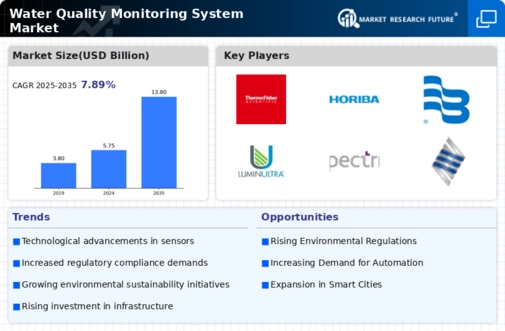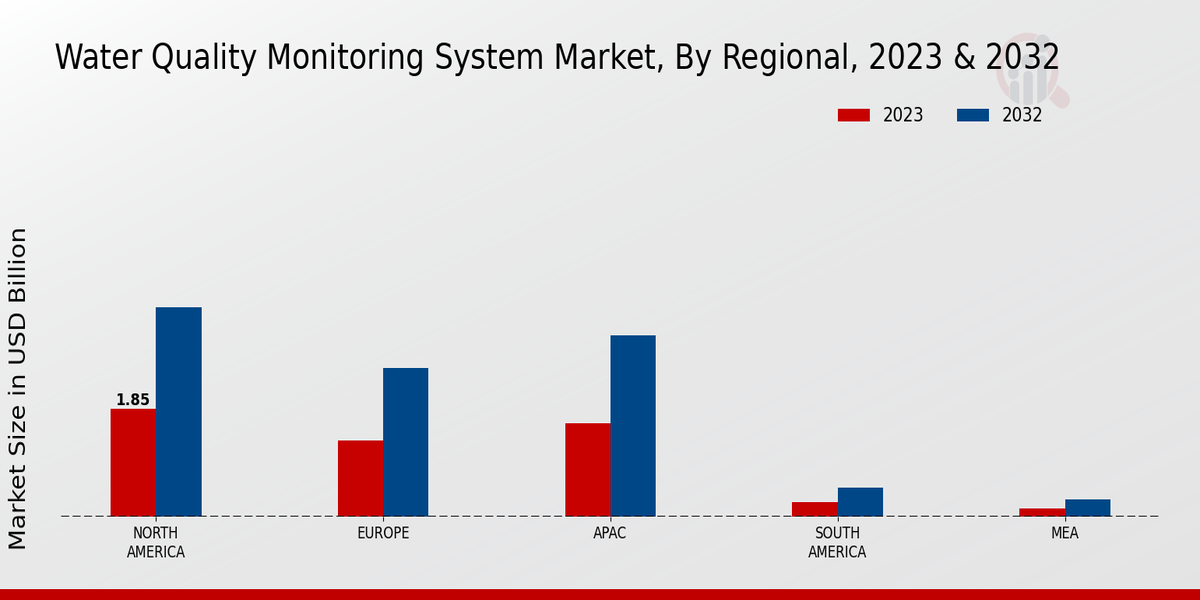Market Growth Projections
The Global Water Quality Monitoring System Market Industry is projected to experience substantial growth in the coming years. With a market size expected to reach 5.75 USD Billion in 2024 and further expand to 13.8 USD Billion by 2035, the industry is on a promising trajectory. This growth is underpinned by a compound annual growth rate (CAGR) of 8.29% from 2025 to 2035, reflecting increasing investments in water quality monitoring technologies and infrastructure. The rising awareness of water quality issues and the need for compliance with regulatory standards are likely to drive demand for innovative monitoring solutions, positioning the industry for sustained expansion.
Technological Advancements
Technological innovations are significantly shaping the Global Water Quality Monitoring System Market Industry. The advent of IoT-enabled sensors and real-time data analytics has revolutionized water quality monitoring, allowing for more accurate and timely assessments. These advancements facilitate continuous monitoring of various parameters such as pH, turbidity, and chemical contaminants. For example, smart water quality sensors can transmit data to centralized systems, enabling rapid decision-making. This trend is likely to enhance operational efficiency and reduce costs for water management authorities. As technology continues to evolve, the market is anticipated to grow at a CAGR of 8.29% from 2025 to 2035, indicating a robust future for innovative monitoring solutions.
Growing Environmental Concerns
Rising environmental concerns regarding water pollution and its impact on public health are propelling the Global Water Quality Monitoring System Market Industry. Increased industrial activities, agricultural runoff, and urbanization have led to deteriorating water quality in many regions. Consequently, there is a heightened demand for effective monitoring systems to detect and mitigate pollution sources. Governments and organizations are investing in comprehensive water quality monitoring programs to safeguard ecosystems and public health. This growing awareness and proactive approach to environmental management are expected to contribute to the market's expansion, with projections indicating a market size of 13.8 USD Billion by 2035.
Increasing Regulatory Standards
The Global Water Quality Monitoring System Market Industry is experiencing a surge due to the implementation of stringent regulatory standards aimed at ensuring safe drinking water and protecting aquatic ecosystems. Governments worldwide are mandating regular monitoring of water quality to comply with health and environmental regulations. For instance, the United States Environmental Protection Agency has established guidelines that require water utilities to monitor contaminants. This regulatory push is expected to drive the market's growth, as organizations invest in advanced monitoring systems to meet compliance requirements. As a result, the market is projected to reach 5.75 USD Billion in 2024, reflecting the urgency for enhanced water quality management.
Investment in Water Infrastructure
Investment in water infrastructure is a critical factor influencing the Global Water Quality Monitoring System Market Industry. Governments and private entities are recognizing the need for modernizing aging water systems to enhance efficiency and safety. This includes the installation of advanced monitoring systems that can provide real-time data on water quality. For instance, initiatives aimed at upgrading water treatment facilities and distribution networks are becoming increasingly common. Such investments not only improve public health outcomes but also support sustainable water management practices. As a result, the market is poised for growth, driven by the need for reliable and efficient water quality monitoring solutions.
Urbanization and Population Growth
Rapid urbanization and population growth are significant drivers of the Global Water Quality Monitoring System Market Industry. As more people migrate to urban areas, the demand for clean and safe water increases, placing immense pressure on existing water resources. Urban centers are particularly vulnerable to water quality issues due to increased waste generation and infrastructure challenges. To address these challenges, municipalities are adopting advanced water quality monitoring systems to ensure compliance with safety standards and to manage water resources effectively. This trend underscores the importance of investing in robust monitoring solutions to meet the needs of growing populations, thereby fostering market growth.















